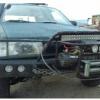-
Posts
846 -
Joined
-
Last visited
-
Days Won
26
jonathan909 last won the day on August 23
jonathan909 had the most liked content!
Profile Information
-
Location
Calgary AB
-
Referral
ej25 phase i vs phase ii via google
-
Biography
Engineer, amateur wrenchpuller
-
Vehicles
95&98 Legacy 2.2, 99 Legacy 2.5, 01 Forester
Recent Profile Visitors
3029 profile views
jonathan909's Achievements

Certified Subaru Nut (8/11)
225
Reputation
-
No, this is a real-world problem. Car died very suddenly on the highway (en route home from the glass shop with a brand-new windshield after a windstorm+tree took it out. Such is my life these days.) and the symptoms are: Cranks, but sounds different, like less stuff than normal is turning; cam position sensor error. That it's turning at all seems like somewhat good news, as that suggests I don't have a piston wedged against a valve, though it doesn't mean there wasn't a hit. Hence the question. So my first guess is a thrown chain (the EZ30 has two). But since then (last week), winter has set in here for real - it's subzero, we're under a foot of snow, and the car is not (yet) in my (unheated) garage, where I'll have to pull the 64-bolt timing cover in order to confirm my suspicion. And first I've gotta bolt a winch onto the far garage wall so I can pull it in...
-
By "earthed solenoid" I assume you mean "grounded the coil of the fuel pump relay". So far, so good. From where you are, I wouldn't jump directly to "bad ECU". Let's go back to first principles, and stop me if I get anything wrong. The initial failure symptom was no fuel, but you know the relay and pump are good, so you changed the ECU, but that didn't solve the problem. You're reading that as "two bad ECUs", where I read it as "ECU not the problem, because you just swapped in a known-good (according to the supplier) one". The whole point of the ECU is that it listens to a whole bunch of inputs and drives a whole bunch of outputs. So I'd be looking at all of the inputs to see which ones need to be satisfied in order for the ECU to want to pump fuel.
-
You've all misunderstood the question. The clip at the end of the shaft that gets stuffed into the diff is not the issue. The clip is there and there's nothing to ask about. The question was about the clip that isn't inside the inner CV joint itself to prevent it from coming apart. I just looked at another couple of that type of shaft at a buddy's house, and there's nothing on them either. So I'm just calling it a $h!++y CV design that relies on the boot to keep it together without any positive retention mechanism for the greezy rollers contained within.
-
How long ago did you do that? If recently, there may still be prayer in your future. Depending on the severity and frequency of overheating, you may have compromised the main bearings - they're what goes if you overheat badly enough, often enough. So if you get the death rattle of spun bearings, STOP IMMEDIATELY and overhaul the engine. If this is caught quickly, it can still be salvaged. If not, permanent crank and/or block damage will result.
-
Oh - you meant the ignition switch. Okay, no argument there at all. Mechanical contacts like that degrade over time, and (as I proved years ago) that's exactly the reason for you not being able to program for your key fobs anymore. But "the ignition" refers to the whole system, and that would have been a bizarre claim, kind of like "my windshield wore out". "Cracked? Pitted?" "No, just wore out, stopped working, can't see through it anymore."
-
On your philosophy of grounds, Disagree Strongly. You can, in fact, have too many grounds, though probably not in this context, rather in small-signal applications that are really noise-sensitive. In that case an excess of grounds can result in what are called "ground loops", which behave like little circuits of their own in which very small currents can circulate and disturb the performance of other circuits, notably amplifiers, which will raise the voltages created by those circulating currents to a point at which they become interference. And while you may think you're being "strategic", you may discover that the electrons do not agree. So while you can often get away with adding grounds arbitrarily, they can come back and bite you in the @$$. Plus, in the Jeep case I cited above, that wouldn't have helped anyway, because it was a +12 line that failed, and the problem wasn't going to be solved without first identifying exactly which one it was.
-
Wow - this has been dogging you for more than a year? Awful. This is not going to be easy. It's easy to say "look for a bad ground". It's quite another to find it. Get the drawings for your exact model and year, because here minor variations count. Then trace every ground and +12V wire, and make sure that both the wire itself and the terminations are good. Here's the example I usually cite: I had a 1997 Jeep Grand Cherokee before moving to Subarus. Ran great for years, until the high-miles motor blew (rod through block). Then it sat over a winter until I dropped in a new engine in the spring. When I started it up again, all of the electricals were wonked out. Turning on the stereo affected the wipers. The lights affected the heater. All of this unrelated stuff was suddenly functionally coupled in the most chaotic manner. I bought the big thick book for that year's model from Chrysler and started tracing wires. Eventually I found that where the big harness passed through the firewall (in the most inaccessible spot, of course), a tiny pinhole in the insulation on a +12V wire had let in enough moisture over time to corrode clean through the copper conductor. Absent that supply line, a bunch of stuff found alternate supply paths - through other things, the result being that both were semi-powered and acted nuts. The lesson is that because the effects were so random and crazy, it would have been a waste of time to try to think them through - you just have to check every wire that can have that kind of global effect, what we call "exhaustive search". The other example is a simpler one: After I had the motor out of my (first) '99 Outback for I-forget-what, the AT got all kooky - the shift points were all over the place. Everything else in the car was fine. Turned out that I hadn't tightened down that big, most-obvious-ground-in-car ground lug on top of the intake. Tightened it and all was well. So the effects can can be globally insane, or just localized to some weird thing.
-
Not looking into the diff; it's just sitting on a jackstand (because we had no intention of messing with that) and hard to see in there. But the CV came out of it with a "reasonable" amount of prying, so my inference is that it's fine. I just don't know how to proceed with putting this joint back together. Obviously, Haynes can't be trusted absolutely, but prior experience with the older-style CV - and common sense - say that there should be a retaining ring... and a groove to hold it. So I'm kind of stuck.
-
I've been awfully quiet, not even lurking, just in one of those not-many-car-problems periods, which is fine with me. But now I'm back with a question. Daughter and I set out to change a couple of ball joints on her '03 Forester today. They were, of course, a PITA to get out, and at this point one is changed. But we ran into a bit of nastiness in the process: The inner CV pulled apart, which was a really rude surprise. I'm accustomed to the older cylindrical type that are roll-pinned to the diff shaft. This one just presses in and the housing is hexagonal. But the shaft and tri-pot roller assembly just pulled out of the housing. Haynes says there's supposed to be a retaining ring in there, but there's no groove for one. So do you just have to be careful never to tension one of these type, because all that's keeping it together is the boot, and if it slides off, you're SOL?
-
Wow - 2019. So many cars since then. Nice that I indicated which it was, otherwise I'd just be guessing. The '01 Forester must have been my daughters' car at the time, since sold, they briefly had a Jeep, then unloaded it in favour of one or both of the Subarus (one '03 Forester, one not-sure Legacy) they have now. I'm perfectly happy with all of the Mahles I've used. In fact, I think that one set I bought was actually of Subaru manufacture, according to the logo on the gaskets. So yeah, I think they're fine.
-
None of the above. Nothing so complicated, simply air getting past the bleeder screw threads. We got our Speedi Bleed yesterday and bled the system today. Quick. Silent. No pumping. Painless. No bubbles. Just Works. This is a great tool. I don't think I've ever specifically endorsed any such here, but it gets a hearty two thumbs-up from me.






